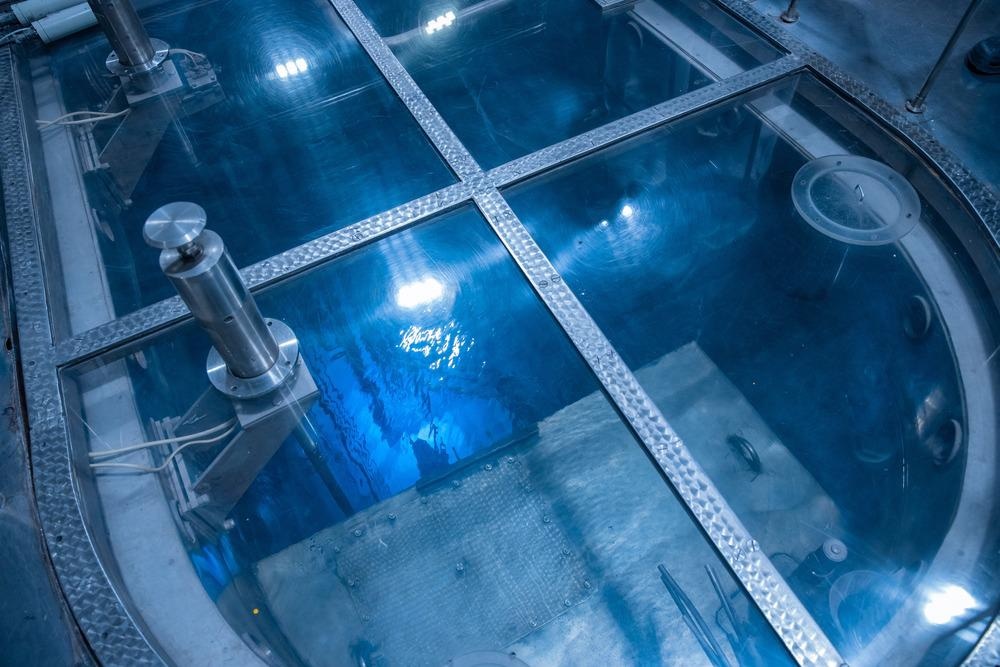In a study available as a pre-proof in the Journal of Nuclear Materials, the swelling behavior of a newly manufactured austenitic stainless steel with uniformly dispersed nanosized NbC precipitates (ARES-6) and conventional 316 stainless steel was investigated following heavy ion irradiation to compare the benefits of ARES-6.

Study: Swelling resistance of an austenitic stainless steel with uniformly distributed nanosized NbC precipitates under heavy ion irradiation. Image Credit: Parilov/Shutterstock.com
Uses of Austenitic Stainless Steels
Austenitic stainless steels (SSs) are commonly utilized as plant inner components in today's light water reactors, where they are exposed to high radiation fluences.
The morphological development of austenitic stainless steel under neutron capture has a negative impact on physical parameters such as irradiation stiffening and thermal decomposition. Deformation looping, holes, and provokes are examples of common radiation-induced microstructural evolutions found in austenitic stainless steels.
Furthermore, austenitic SSs are prone to radiation-induced vacuum enlargement, which could be a potentially fatal degradation of the reactor's core components. As a result, the innovation of modern nuclear reactors with longer lifetimes and greater productivity necessitates the use of sophisticated components capable of withstanding larger irradiation treatments.
Methods to Develop Radioactive Materials
Many ways to develop radioactive materials have been proposed ever since the early 1970s. The functions of core aspects on vacuum enlargement resilience have been explored as part of an effort to increase radiation efficiency. But even so, because high-nickel austenitic stainless steels are highly vulnerable to irradiation embrittlement due to transfigured helium droplets, lower austenitic stainless steels are hard to guarantee adequate protection against corrosion in aggressive conditions. Improving radiation efficiency by tweaking alloy configurations would also have some restrictions.
Another method is to include diverse microstructural characteristics that might serve as drain spots for point faults. The sinks may facilitate the absorption of radiation-induced intrinsic defects, delaying the creation of holes and displacement circles generated by vacancy and interstitial grouping.
A large number of misalignments, tiny precipitates, and grain structures have been proposed as sinks that might increase radiation efficiency. Dynamic rate concept designs and several observational investigations have established the benefits of these microstructural characteristics in inhibiting void enlargement and lowering radiation-induced component separation. Nevertheless, discontinuities would progressively heal under irradiation and would not function adequately as drain spots.
Researchers recently generated austenitic stainless steels with a sizable proportion of nanosized Niobium carbide precipitates evenly dispersed in the matrix using a commercial steel-producing technique, which was subsequently dubbed ARES-6.
It was expected that a substantial percentage of precipitates would offer enough drain locations for radiation-induced intrinsic defects, hence improving the radiation efficiency of ARES-6 alloy. However, the existence of tiny niobium carbide precipitates does not ensure the expected radiation-resistant properties based on frameworks.
As a result, the goal of this research was to verify the favorable impact of small niobium carbide provokes on swelling resilience. The dose rate impact was also studied in relation to the durability of nanosized provokes during heavy ion bombardment.
Achieved Outcomes
To explore gap enlargement, a newly produced ARES-6 alloy with evenly dispersed nanosized niobium carbide provokes and commercial steel was bombarded with 5 MeV Nickel ions. The following findings were reached based on swelling measurements, TEM microstructural studies at the nano-scale, and sink strength calculations.
Among the microstructural properties of ARES-6P, a high concentration of nanosized niobium carbide precipitates was the most significant reason for increased swelling resilience, albeit a high nickel concentration also played a role. Given the high frequency of misalignments, ARES-6HR exhibited comparable swelling to ARES-6SA, indicating that the displacement on its own in ARES-6HR would not offer effective drain locations despite the increased sink design strength.
The nanosized quasi-crystalline nature of niobium carbide precipitation was disrupted after heavy ion bombardment. As a result, at the heavy-ion bombardment setting utilized in this work, the majority of the pre-existing provokes in the un-irradiated specimen were progressively dispersed into a matrix.
Despite the fact that ARES-6P was anticipated to have three times larger drain ability than 316 stainless steel sheets, the measured gain in swelling was roughly a factor of seven.
The dissolving of nanosized niobium carbide precipitates during illumination explained the substantial difference between ARES-6P's expected and actual swelling tolerance. Nevertheless, it is expected that the nanosized niobium carbide crystallites will be considerably more durable at a lower dosage rate, and ARES-6P's swelling resilience will be significantly higher under normal nuclear power plant settings in the future.
Reference
Shin, J. H., Kong, B. S., Jeong, C., Eom, H. J., Jang, C., & AlMousa, N. (2022). Swelling resistance of an austenitic stainless steel with uniformly distributed nanosized NbC precipitates under heavy ion irradiation. Journal of Nuclear Materials. Available at: https://www.sciencedirect.com/science/article/pii/S0022311522001714?via%3Dihub
Disclaimer: The views expressed here are those of the author expressed in their private capacity and do not necessarily represent the views of AZoM.com Limited T/A AZoNetwork the owner and operator of this website. This disclaimer forms part of the Terms and conditions of use of this website.